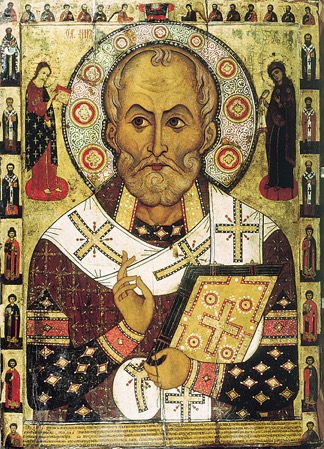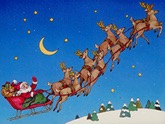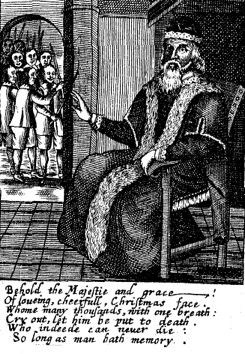I originally wrote this for our local newspaper, where I write a science and community health column. I’m posting it here as a public service. It’s not about rural community health, per se, but I think it isn’t that far off, either. It’s about heart and kindness and magic. The world needs more magic, now more than ever. If you know someone who is a confirmed Grinch or maybe a little one starting to be a little skeptical, share this with them and maybe we can bring a little magic back for everyone!
I hear arguments from certain kids, particularly when they get to a certain age, who think it’s not cool to believe in magic and that Santa Claus can’t be real because of all the logistical issues involved in providing toys to every kid in the world on one night. To that, I say, “Bah! Humbug!” He can, and I’ll tell you how.
First off, let’s establish the boundaries of our issue. Santa doesn’t have to go to every dwelling on the planet. Santa is only on duty for about half of the world’s population. Most of the rest of humanity relies on alternative methods for the delivery of love, gifts and goodwill at various times of the year. Many Muslims, for instance, celebrate the end of Ramadan, their most holy month, with Eid ul Fitr, where gifts are exchanged and people join together and reflect on the month of fasting. Hindus celebrate Diwali, the festival of lights, in autumn, with lots of gift-giving, worship and gratitude. Santa Claus only has to worry about the part of the world that observes the western Christian traditions of Christmas. The human population of the Earth is now about 7.5 billion people, so 3.75 billion of those are in Santa’s area of responsibility. Santa is, as we know, primarily interested in kids, and of that 3.75 billion, roughly a billion are kids. So Santa doesn’t have to visit 7.5 billion people in one night—he only has to visit about a billion. If the average number of kids per household (worldwide) is about 2.5, that means he only has to hit about 400 million different homes. That is, obviously, WAY easier than 7.5 billion different stops. So that part of the “problem” is more manageable than it seems, at first.
I’ve also heard about the problems of toy manufacturing capacity at the North Pole headquarters. This is, indeed, an issue that requires a great deal of effort and sophistication to overcome. Back in the day, Santa could handle toy manufacturing in-house, using his elfin labor force, but times, as we know, change, and they changed at the North Pole, just as they did everywhere else. Where the economy of the North Pole used to be based solely on toy manufacturing, it is now diversified to include a very large service-based component. There is still, obviously, a substantial amount of toy making going on in Santa’s facilities. As toys have gotten more modern, of course, their manufacturing has evolved to keep up. Most of the toy production now is done under license from the regular toy companies, so the elves can build things kids ask for, like Playstations or Legos, without getting into legal trouble. However, Santa has one of the largest IT departments in the world, and many of the elves these days are busy ordering toys online from regular manufacturers. Doing this sort of “just in time” ordering, which is a standard way of doing business in most industries, helps with toy storage and distribution, because Santa can have things delivered to computerized and highly automated distribution centers all over the world where he can stop and refill the sleigh. Carrying toys for a billion kids all at once would obviously be very difficult, and would require a really, really big sleigh. Such a sleigh would require some pretty substantial power to move, and a flying-reindeer-based propulsion system is somewhat limited in its power generation capacity. With computers, barcode scanners, robotic inventory control, artificial intelligence, and advance logistical management, Santa has been able to expand his toy distribution capacity to keep up with growing demand. Being one of the elves these days requires education. Santa now has computer programmer elves, graphic designer elves, all kinds of engineer elves, chemist elves, physicist elves, accountant elves, elves who specialize in logistics, medical elves and a host of other high-tech elves to go along with all the artists, craftsmen, carpenters, warehouse workers, machine operators, food service elves, clerical workers and on and on. So, as you see, Santa isn’t any longer just a toy maker—he’s the CEO of a large, technologically advanced, diversified toy distribution and manufacturing network.
Now, for the big problem those smarty-britches people always bring up to cast doubt on Santa. This is, of course, the problem of speed. Usually, they start with the whole population of the Earth because they haven’t done their research. They say something like, “if Santa was to visit everyone in the world in one day, he would have to visit over 90,000 people every second”, which is 7.5 billion people (total population of the world) divided by 86,400 (number of seconds in a day). Well, first off, we’ve already determined that he only has to visit about a billion kids who live in 400 million houses, so he actually only has to stop at about 4600 homes every second, which is obviously MUCH easier to do than 90,000. This goes to show that it’s very important to do your preliminary research so you get the right information before you start trying to come up with answers. You have to know if you can trust the information people tell you. Sometimes, they are wrong. Like the smarty-britches kids who try to say Santa isn’t real because he would have to visit 90,000 people a second on Christmas Eve.
While it is obviously easier to stop at 4600 homes a second, rather than 90,000, it is still a pretty tall order. In fact, we’ve already talked about things like momentum and inertia in some of my other columns that would make starting and stopping the sleigh that many times in one second pretty hard. The sleigh would be pretty heavy, even with regular refills being done at the distribution centers, and it would take a lot of energy to stop and start it 4600 times a second. Fortunately, Santa doesn’t have to deal with that, because he isn’t stuck with the same limitations we are. We’ve already talked about his high-tech operation. There is also the fact that he is several hundred years old, as we reckon time, so there is something going on there, as well. How about the North Pole headquarters? Santa’s operation is huge. How come nobody sees it? A corporate campus that big, even if it was at the North Pole, would be hard to miss. And about this North Pole thing. The North Pole is located on the ice floating in the middle of the Arctic Ocean. It’s not land, like where the South Pole is in Antarctica. The North Pole is not a good place to build a highly advanced manufacturing and information technology operation. So, the smarty-britches peoples are saying that all of that is just more reasons why Santa can’t be real. But they are, of course, wrong. They are wrong because Santa is magic. Magic? I can hear the smarty-britches brigade from here! “There’s no such thing as magic!”, they are hollering. Nonsense, I say! There is magic everywhere! It’s just a matter of perception. Arthur C. Clarke, one of the most creative and imaginative writers of the twentieth century, wrote that “any sufficiently advanced technology is indistinguishable from magic”, and he was right. You and I know that a cell phone is just the result of good design and advanced engineering coming together to make a very useful piece of technology that we use every day, but I bet if you showed that phone to someone who lived in a primitive village in the middle of the jungle, he would know, just as surely, that it was magic. For that matter, if you could go back in time to about 1900 and show that phone to someone in New York City, they would probably think it was magic, too.
Santa is magic because Santa has learned to use Physics in ways the rest of us haven’t figured out, yet. Santa is, of course, subject to the same physical laws as everyone and everything else. He is just able to apply and use those laws in ways we haven’t discovered, yet. The reason Santa can visit 4600 houses in what we see as one second and the reason that we don’t see his workshop or distribution centers is that he isn’t restricted to just the three dimensions (Length, width and depth) that we are restricted to in the universe that we live in. There is now a really interesting hypothesis in Physics that there is not just one universe—there are an infinite number of universes, called the multiverse. The different universes in the multiverse exist in parallel with each other, and time and space are just slightly different from one parallel universe to the next. For instance, the second we are currently living in in our universe might be one second ago in one parallel universe and one second from now in another. Time is not locked from universe to universe, so theoretically, you could stay in the same moment in time if you could just move from one universe to another that is just slightly shifted in time. Obviously, Santa has figured this out. By moving between universes, he has all the time he needs to get from one house to the next. Moving among the different universes and back again to ours allows Santa to stay in one particular moment of time in our universe for as long as he needs to. The multiverse theory also explains the real estate issue regarding his facilities. His headquarters is, indeed, at the North Pole, but it’s at the North Pole in one (or more) of the parallel universes, so we can’t see it. Problem solved!
One other thing that needs to be addressed this year is the coronavirus. There is a lot of concern about the spread of the virus and having somebody pop in and out of several hundred thousand houses would definitely not be a good idea in a time like this. However, there is no need to worry about that. As we all know, Santa is actually a “right jolly old elf”, and elves are immune to the virus, so he won’t get sick or spread the virus in his travels.
So, for all those kids (including the older ones), who are beginning to doubt the existence of Santa Claus or of magic, in general, because it doesn’t make sense, I say you might want to rethink your arguments. Santa isn’t just the tubby, red-coated, jolly figure most of us grew up with. He is different for different people. St. Nicholas was, or maybe we should say, he began as a real person, back in the 4th century in Greece. His name in Dutch is “Sinterklass”, which is where we get the name “Santa Claus”. In England, he is Father Christmas. Some people see him as that “right jolly old elf” like we do. Lots of people think that the common image of Santa in his red-and-white regalia is the product of a Coca-Cola advertising campaign from the 1930’s, but they are wrong. The white beard and red outfit have been around much longer than that. Others see a tall, thin man wearing green robes. How we see him doesn’t matter. It is what he represents to us that matters. He is the image of the good in all of us, at the one time of the year where we, as people, get closest to what we could be–when we see the world a little less cynically and treat each other with a little more kindness.
What we humans know is just a tiny, tiny speck of what there is to know. Just because we can’t understand it or even imagine it doesn’t mean it doesn’t exist or can’t exist. As long as something doesn’t violate the laws of Physics, it is possible, and the distance from possible to magical isn’t very far at all, sometimes. And if that’s not enough of an argument for you, how about this—the world is a very much more beautiful, wondrous place with magic in it than without. That should be reason enough to believe. Merry Christmas! And if your particular belief system doesn’t include Christmas, I hope whatever you believe in and however you choose to celebrate it, it brings joy and peace to you and yours, today and all the year through.

Picture of St. Nicholas, 1294.


Father Christmas, 1686

The 1881 illustration of Santa Claus by Thomas Nast, first published in Harper’s Weekly
Fabulous!